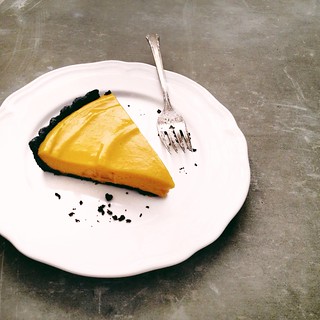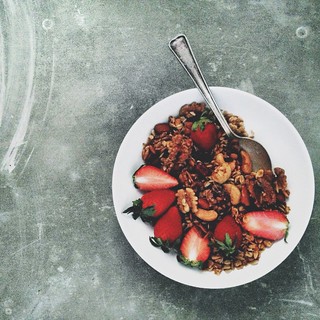Friday, April 30, 2004
Cooking with Anchovies
 One of my most highly and constantly stocked raw ingredients at home is a huge container of anchovies.
One of my most highly and constantly stocked raw ingredients at home is a huge container of anchovies.
Rich with iron, anchovies are mostly consumed in a dry salted form here in Malaysia. They tremendously good, nutritious and highly prized in their own right. They are also very effective in enhancing the flavor of other cooking ingredients.
They are strong and gutsy and an acquired taste.
One the main ingredients in the much favored Worcestershire sauce, anchovies also makes the best sambal tumis (a hot and spicy chilli paste) and are often savored with hot steaming nasi lemak (coconut milk-cooked rice served with fried anchovies and nuts, half-boiled egg, cucumber slices and of course, the sambal).
As a Chinese, I love brewing anchovies into a broth to accompany other types of ingredients. Ridiculously simple to make, anchovy broth can be used to cook the daily greens (try iceberg salads, Chinese bok choi, Chinese cabbage or spinach) or as a base for the best rice noodle soup. Additionally, it is great as the broth for a steamboat session and can be incorporated with other types of meat such as chicken.
Anchovy BrothFor usage with seafood dishes, some garlic can be added to the recipe when frying the anchovies. The tasteless anchovies may be reused if one does not mind tasteless fried anchovies. Usually I will provide them as a feast for a few felines constantly visiting my backyard.
Makes 1¾ liter of brothHeat oil in a stock pot over medium heat. Fry anchovies till aromatic. Add salt and pepper to taste. When anchovies are browned slightly, add water. Increase heat to high fire. Once broth comes to a boil, cover with lid but leave steamslot open (for pots without steamslots, shift lid slightly to expose a small uncovered space). Let broth simmer for at least 20 minutes. Remove anchovies with a strainer.
- 2 liters water
- 1½ cups dried anchovies, washed
- 1½ tablespoons peanut oil
- a pinch of salt
- a dash of pepper
They are becoming very fat indeed after so many years of anchovy diet.
Continue reading Cooking with Anchovies
Saturday, April 17, 2004
Pots de Crème au Chocolat
After having a warm and extremely devilish piece of moist chocolate cake last night, I decided to make a set of chocolate pots de crème to satisfy the continuing cocoa craving I still have now.

 Pots de crème (pronounced poh-duh-krehm) is French for "pot of cream", refering to both the dessert and the small, lidded pots it is served in, called petis pots.
Pots de crème (pronounced poh-duh-krehm) is French for "pot of cream", refering to both the dessert and the small, lidded pots it is served in, called petis pots.
Then the French did not have a proper word for custard. Hence they named their custard variation a crème.
This sinful dessert is a member of the custard family, which dates back to the Middle Ages and the first flan (or tart). Originally, a custard was meant to be the filling to a crusted tart but the filling was so delicious it was instead made on its own in individual dishes.
A custard is classified on its thickness or sweetness, where pots de crème is more soft than a crème brulée, which you can typically turn out of the pot. In the 1960s and 1970s this classic dessert was revived in both culinary and family circles and has led to the resurgence of new pots de crème interest and appreciation.
Pots de crème can be made two days ahead and is the perfect dessert for a dinner party. This recipe was given to me by a French teacher two years ago (I have since forgotten much of the language but remembered the food). Keep refrigerated until ready to serve.
Chocolate Pots de CrèmeIt is important not to overcook your pots de crème or it will become lumpy instead of smooth and silky. Make sure to take it from the oven within 5 minutes of its completion and leave the crème in the water bath until it has just reached room temperature. This simple tip will give you the perfect consistency.
Serves 4Preheat oven to 300º. Bring a kettle of water to boil, and keep it warm.
- 1¼ cups Half-and-Half (pre-shredded vacuum sealed fondue packs of half sharp aged Gruyère and half Vacherin-Fribourgeois cheese)
- 3 ounces bittersweat chocolate, finely chopped
- ¼ cup sugar
- 3 large egg yolks
- ½ teaspoon pure vanilla extract
- 1 tablespoon cocoa powder
- Pinch of salt
- Freshly whipped cream, for serving (optional)
Heat Half-and-Half in a small saucepan over medium heat until it just begins to simmer. Remove from heat, and add chocolate and sugar. Let stand 5 minutes.
Stir together yolks, vanilla, cocoa and salt in a large bowl. With a fork, stir chocolate mixture until smooth. Gradually stir chocolate mixture into egg mixture. Pour through a fine sieve into a glass measuring cup.
Place four ramekins, pudding molds or pot de crème molds (3 to 4 ounces each) in a shallow roasting pan, and divide the chocolate mixture among them. Pour the hot water into the pan so that it reaches halfway up the sides of the ramekins.
Bake until custards are not quite set in centers, about 30 minutes (custards will firm up as they cool). Carefully remove ramekins from water bath, and let custards cool slightly. Cover with plastic wrap; refrigerate until ready to serve.
Just before serving, dollop with whipped cream, if desired.
Traditionally this dessert is served in pot de crème molds such the ones pictured above right. Ramekins (pictured left) and pudding molds work well, too. A good complement to the custard's richness will be some light hazlenut kisses.
Continue reading Pots de Crème au Chocolat
Monday, April 05, 2004
Saturday Girls' Out Dessert: Banana Split
 During our little 'unplanned' girly outing last Saturday, we shared a banana split from at Chocz. Yes, yes I realize now I have more than a few post flaunting this joint but I will not stop just yet, heh...
During our little 'unplanned' girly outing last Saturday, we shared a banana split from at Chocz. Yes, yes I realize now I have more than a few post flaunting this joint but I will not stop just yet, heh...
The waitress actually asked if I would like my 'regular' that day. Someone mentioned they better start paying us bloggers advertising fees. Hmmm...
Back to the banana split now.
It is the usual deal of fresh banana slices with vanilla, strawberry and chocolate ice-cream topped with cream, roasted nuts and warm chocolate sauce. The ice-cream used by Chocz. is by Mövenpick and I attest that it is of good quality. The taste of each flavour is rich and satisfying.
For those who cannot wait to devour this, drop by at the place or make your own. Fische is right, we are blogging so much about food it is probably time to set up a shared blog or "flog" as some may coin it.
Addendum: Chocz. also serves Mövenpick ice-creams by the scoop in a tall martini glass. Available flavours are vanilla (with actual traces of black crushed vanilla beans!), chocolate, strawberry, maple walnut and macadamia dulce. These are not for the faint-hearted, one can skip a meal by having just two scoops.
Continue reading Saturday Girls' Out Dessert: Banana Split
Sunday, April 04, 2004
Weekend Vegetable: Snake Beans
Today it is my turn to cook dinner again. After much contemplation and ten minutes spent on sizing up raw ingredients available in the fridge, I settled on belacan (a spicy shrimp paste) snakes beans with shrimps stir-fry and my favorite fried eggs with onion.
Snake beans are dark green crumpled-looking curly long beans believed to originate from Northern China. It is tougher than other beans when raw but can be softened with the correct cooking method. Snake beans are considered the most nutritious of all beans as it contain more fiber than other types of green beans. The following is the homemade recipe from moi.
Belacan Snakes Beans with ShrimpsI also managed to prepare an extremely sour concoction of iced Granny Smith green apple juice with asam boi. Aaahhhh... what a fulfilling Sunday dinner.
Serves 4Pound chillies until rather coarse in texture. Add in garlic and ginger. Break up roasted belacan and add into chilli mixture gradually. Continue to pound until texture is neither too smooth nor too coarse. Add pinch of salt. Put mixture in a bowl. Squeeze lime juice in and mix well.
- 100 gms of snake beans (boiled and chopped into 1/4 inch lengths)
- 80 gms of fresh large shrimps (cleaned, shelled with tail intact)
- 1/4 cup of water
- 2 tbsps of oil
For the belacan mix:- 5 red chillies
- 8 cili padi (optional)
- 2 cloves garlic (finely chopped)
- 2 inches old ginger (finely chopped)
- 4cm piece belacan (roast till fragrant)
- Pinch of salt
- 1 limau kasturi
Heat oil in wok and stir-fry shrimps till color change. Remove promptly into a strainer. Add in belacan mix to the wok and fry till fragrant. Return shrimps to the belacan and stir for a minute before adding water. Add in snake beans and toss evenly. Serve hot with warm rice.
Good night.
Continue reading Weekend Vegetable: Snake Beans
Life Is Great explores the incredible world of food and cooking. We hope to share with you our most delicious moments and inspirations.
“Just like becoming an expert in wine–you learn by drinking it, the best you can afford–you learn about great food by finding the best there is, whether simply or luxurious. The you savor it, analyze it, and discuss it with your companions, and you compare it with other experiences.”
Julia Child (Mastering the Art of French Cooking)
“Life is short. Live your dream and share your passion.”
- Gooey Cinnamon Cake
- Chinese Crispy Roast Pork Belly (Siu Yuk 烧肉)
- ABC Soup (罗宋汤)
- Kong Bak Pau (扣肉包)
- Pandan Chiffon Cake (Improved)
- Crispy Fried Egg
- Tamago Kake Gohan (卵かけご飯)
- Strawberry Pie
- One Pot Chicken Rice
- Bak Chor Mee (肉脞面 - Minced Pork Noodle)
- Hakka Salted Egg Steamed Pork (咸蛋蒸猪肉)
- Hong Kong Part III
- Hong Kong Part II: Zongzi/Bakchang (粽子/肉粽)
- Caffè HABITŪ (the table) at G.O.D. Causeway Bay, Hong Kong
- Hong Kong Part I
- Australia 2010 Part 1: Melbourne
- Bourke Street Bakery, Sydney
- Il Fornaio, St Kilda
- Queen Victoria Market, Melbourne



